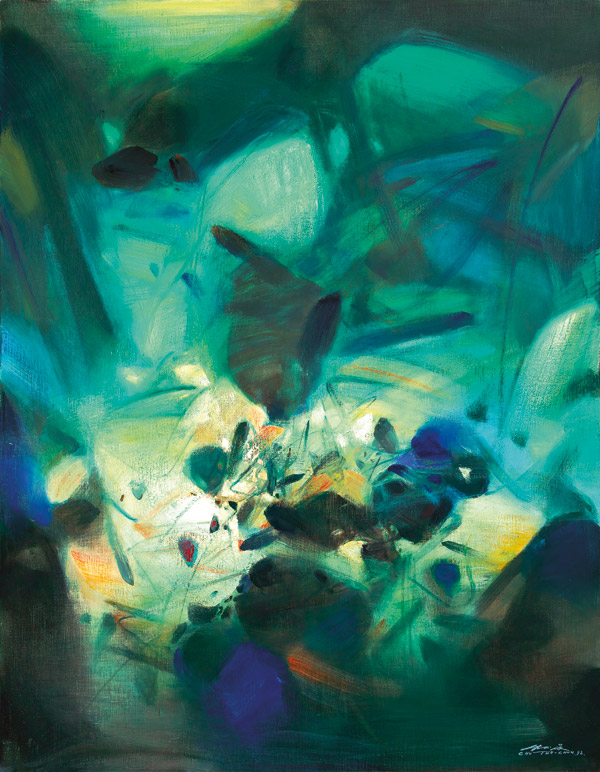The idea that the purpose of art is not merely to depict what the eye can see, but rather to make visible what the eye cannot see, was the single most important thread guiding the development of Western art during the twentieth century. This concept represented a major reshaping of the Western artistic tradition, which had for centuries emphasized rationalist, scientific principles, and led to Western artists seeking inspiration from traditional Chinese aesthetics. During his time at the School of Fine Arts in Hangzhou, Chu Teh-Chun had already established a solid foundation in both Chinese and Western artistic technique, and had embarked on the process of bricolage whereby he gradually put together his own artistic lexicon. During this period, Chu Teh-Chun was exposed to the new trends that were sweeping the global art world, and was personally affected by the process of exchange and interaction between Western and Chinese culture. When Chu arrived in Paris in 1955, the conflict between the figurative and abstract schools was at its height. The following year, Chu had the opportunity to view an exhibition of works by Nicolas de Staël at the National Museum of Modern Art in Paris; de Staël's work proved to be a major source of inspiration for Chu, encouraging him to embark on his own exploration of abstract art, an exploration that brought together traditional Chinese painting and calligraphy and modern abstract art.
This particular work, "Sublime perspectives", was created in 1992. As the result of an ongoing process of artistic exploration and discovery, Chu Teh-chun's artistic trajectory had moved away from introspection towards a more extroverted approach, while retaining the effective use of color and line to create "landscapes of the mind" that had been a constant element in Chu's work throughout his career. By the 1990s, Chu's work had become freed from all inhibition; his spatial composition had become more striking and self-assured, and his use of color was smoother and more elegant. This painting employs Chu Teh-chun's favorite color tones, using a wide range of blue tones in combination with blue-green. Chu once said that he associated the color blue with the mysterious quality of the ocean and the way it constantly changes, sometimes calm and serene, sometimes wild and violent. Here, Chu's use of blue adds an air of solemnity to what is otherwise a highly dynamic painting.
In this painting, the relationship between composition and color is particularly exquisite. The positioning of an oval composition within a rectangular frame creates a visual contrast between stasis and movement, which is one of the characteristic features of Chu's art. Rather than just adding large swathes of blue or green to the canvas, Chu has flourished a large brush back and forth, using a combination of long and short strokes, to portray the zen-like flow of blue and the magnificent stillness of green. The light reflected in the painting seems to come from a far-distant, as yet unexplored source. Having traveled such a long distance, the rays of light are unable to fully dissect the spatial and color composition of the work; instead, they seem to "float" over it, like air. The darker dots and lines, with their manic energy, are the "energy source" for the painting's dynamism, guiding the viewer's gaze around the canvas. The large patches of dark color tones that dominate the corners of the painting ensure that, even when the fantastical variations in blue and green color tone are contained and stabilized by black brushstrokes, this calmness does not degenerate into a sense of loneliness or isolation. At the same time, the faint touches of white or yellow that can be discerned in the blue act, through the medium of the viewer's perception, to suggest the emission of light, while the extended perspective provides enhanced freedom for the play of color. The patches of indigo constitute the "soul" of the painting; they represent the self-observation of poetic metaphor, and hold together the poetic rhythm of the work, keeping its precision and restraint. These color elements take the center of the painting as their axis, spreading out from it in interleaving layers. The dense brushstrokes and intense colors safeguard a sense of emotion and internalized memory that is as fine and precise as a point of light; the individual's will is placed within the majestic dynamism of life. This work embodies a progression from taking inspiration from the material world to taking inspiration from the soul, so that, when the artist puts down their brush and stands in front of the canvas, the sense of joy is undiminished.
Chu Teh-chun undertook an unceasing process of exploration in which he sought to find the best way to portray quite observation of the myriad aspects of the material world, along with a sense of supreme tranquility. This journey led him down a path in which he developed his own distinctive abstract style, and gave him an unchallenged, unique place within the Chinese and Western art worlds. Chu was a Chinese artist who, having absorbed the essential elements of Chinese culture and art, was then able to fuse them with the key aspects of Western art. By contrast with post-war Western abstract expressionist art, in which a sense of alienation and powerlessness seems to grow steadily more pronounced, and which focuses on the unease, disturbance and upheaval within the human soul, Chu Teh-chun successfully employs the Eastern philosophical and painting traditions to reaffirm the traditional idea of harmony between the human soul and the workings of the natural world through his depiction of cosmic phenomena and the invisible landscapes of the human heart.
